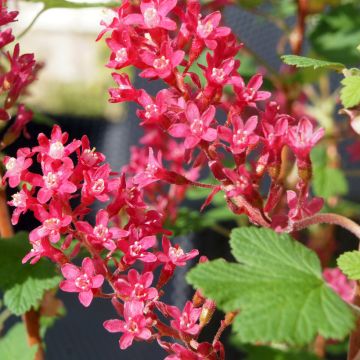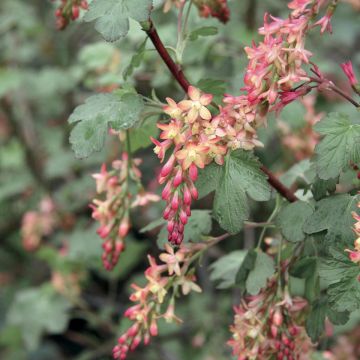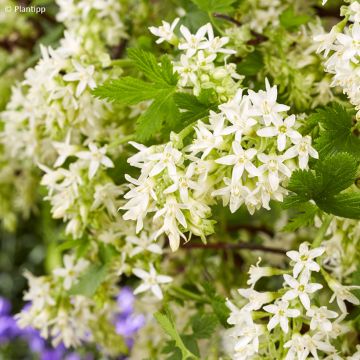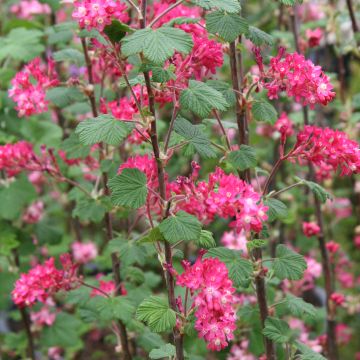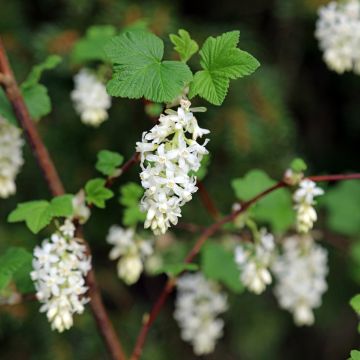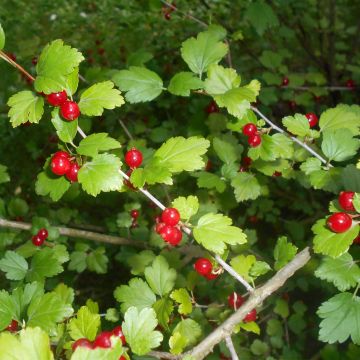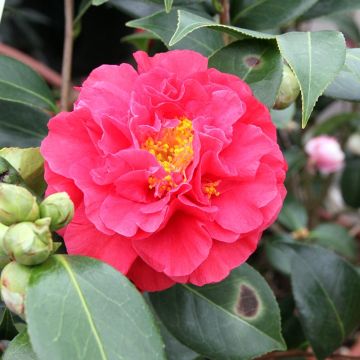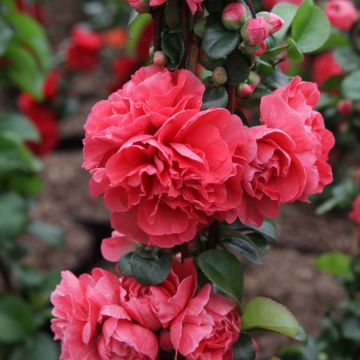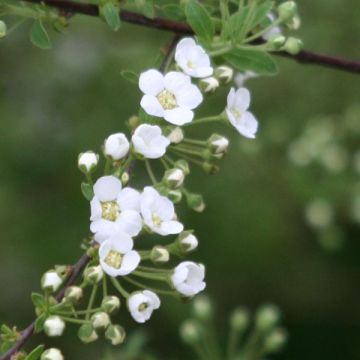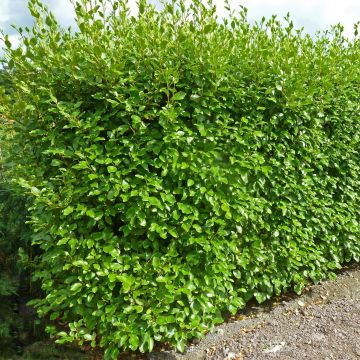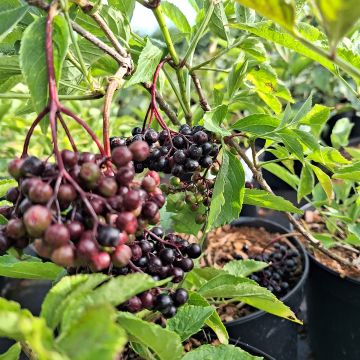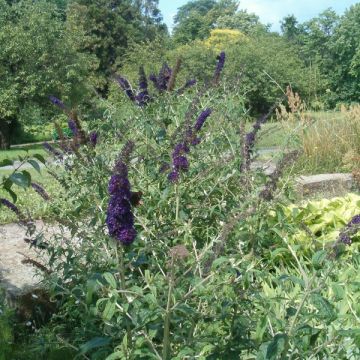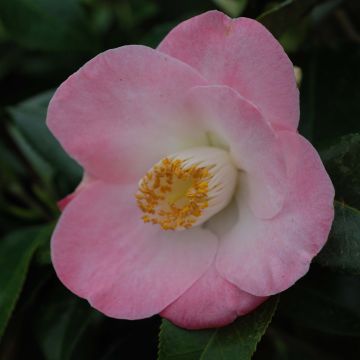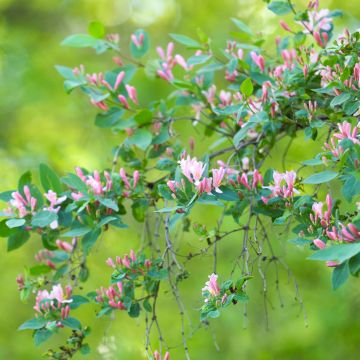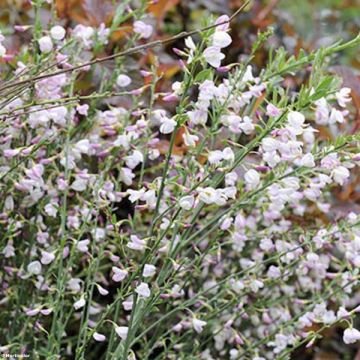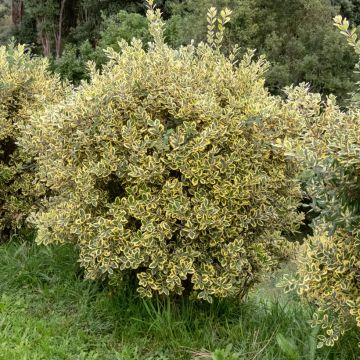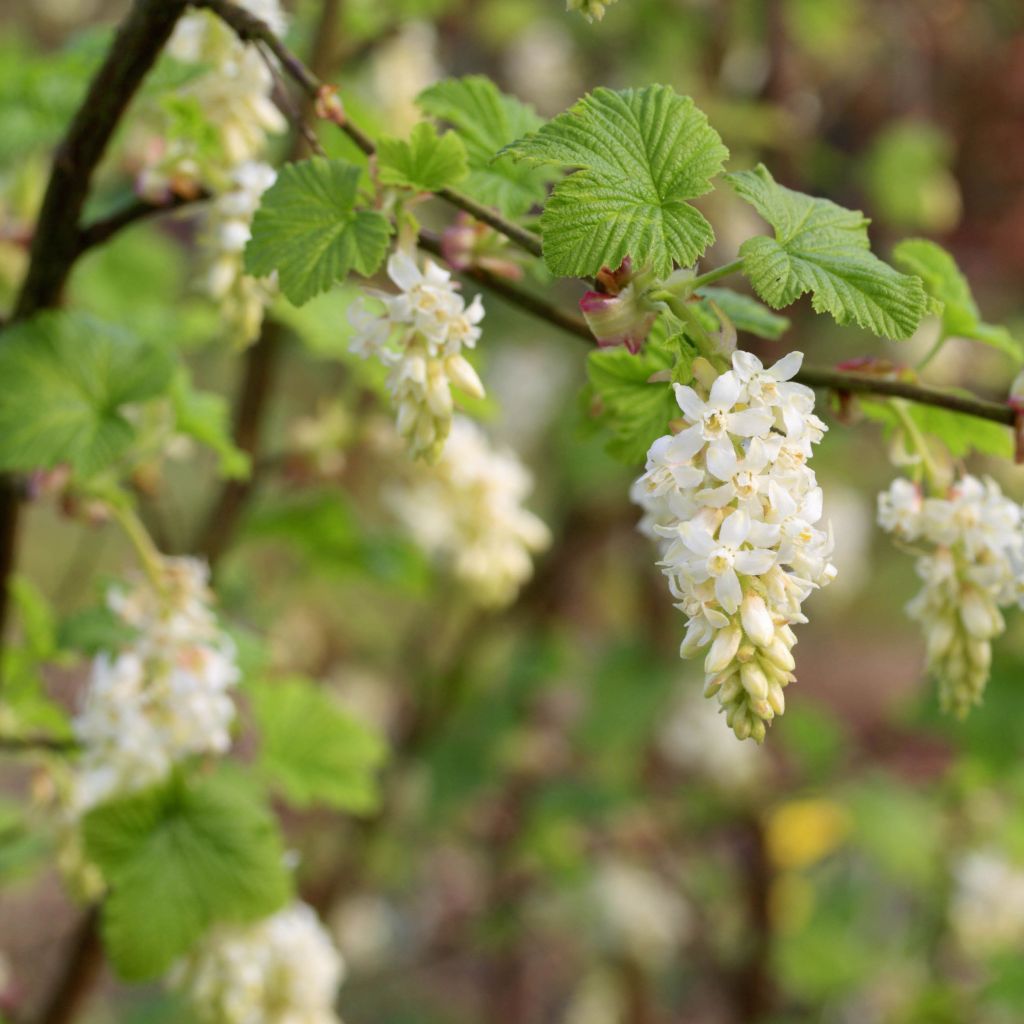

Ribes sanguineum White Icicle - Groseillier à fleurs blanches
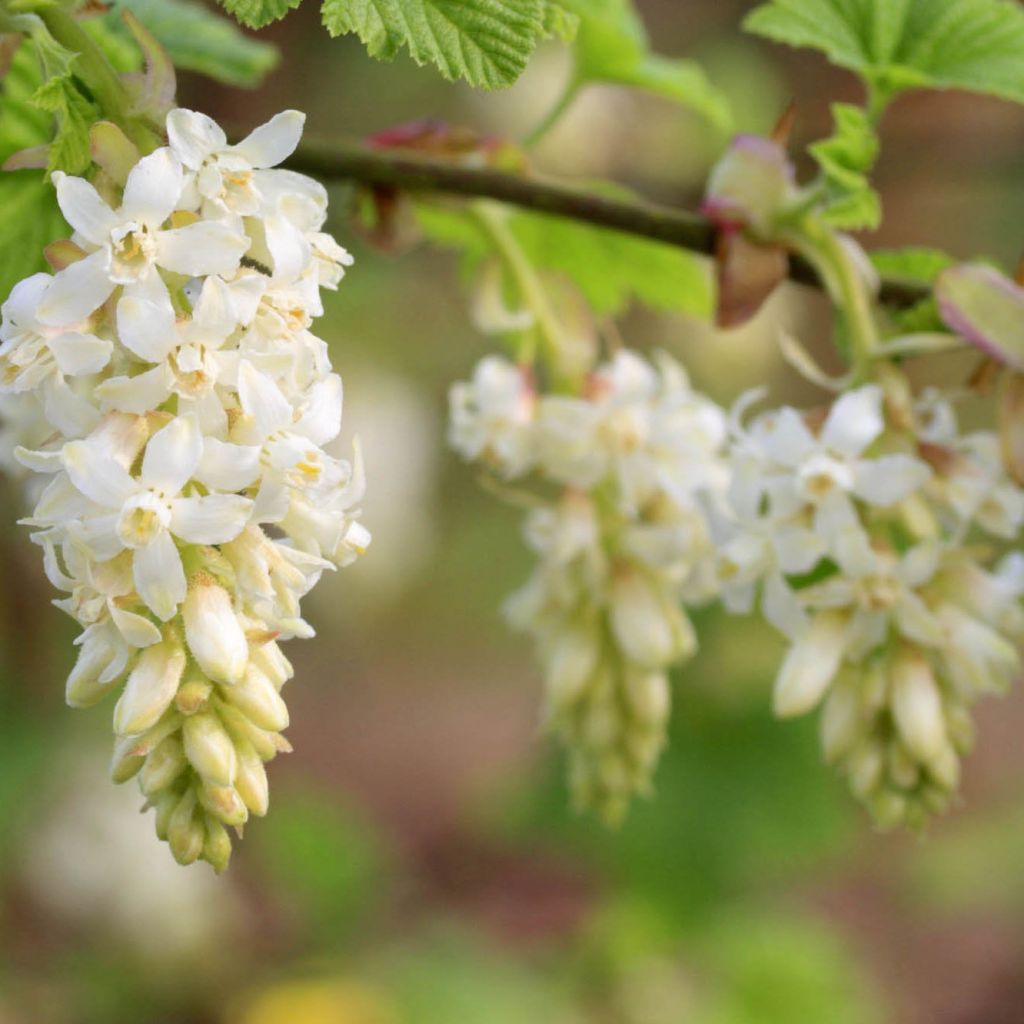

Ribes sanguineum White Icicle - Groseillier à fleurs blanches
Ribes sanguineum White Icicle - Flowering Currant
Ribes sanguineum White Icicle
Flowering Currant, Red-flowered Currant, American Currant, Blood Currant
This plant carries a 24 months recovery warranty
More information
We guarantee the quality of our plants for a full growing cycle, and will replace at our expense any plant that fails to recover under normal climatic and planting conditions.
From €5.90 for pickup delivery and €6.90 for home delivery
Express home delivery from €8.90.

Does this plant fit my garden?
Set up your Plantfit profile →
Description
Ribes White Icicle is a rare, charming, gracefully shaped and rustic-looking spring bush. This Flowering Currant, very early, with large pendulous white clusters of sweet-smelling berry fragrance, and a lovely deciduous, tender green aromatic leaves, is of incomparable elegance. Even in shade, it's illuminated by its abundant immaculate flowering and very bright foliage. Extremely hardy, easy to grow and perfectly suited for beginner gardeners, this white Flowering Currant adapts well to any good, well-drained fresh garden soil and a sunny or semi-shaded exposure. This new variety is a true favourite that will fit wonderfully in many garden settings!
Ribes sanguineum, better known as the Flowering Currant, belongs to the Grossulariaceae family. It is native to the west coast of the United States. This bush is quite common in many gardens, for its graceful spring flowering in pendulous clusters, mostly pink. But this new variety, White Icicle, from Canada, is on the other hand, very rare. This cultivar forms a vigorous, globose-shaped bush, with branches branching out from the base, thus presenting a dense rounded and bushy tuft. The erect stems, a beautiful mahogany brown, arch nicely at their ends. With rapid growth, it easily reaches 2 to 3m (7 to 10ft) in height and width. Its deciduous foliage consists of tender green leaves with long petioles, lobed, finely toothed, rough, but downy on the reverse, measuring 4 to 5cm (2in) long. When these leaves are crushed, they give off delicious blackcurrant fragrances. In autumn, this foliage takes on superb copper-yellow colours. In March-April, while the leaves are just starting to appear, it is covered with a multitude of small pure white tubular flowers, grouped in pendulous and fragrant clusters. These racemes, larger than those of the species, measure 10 to 13cm (4 to 5in) long. This early and spectacular flowering, contrasting wonderfully with the almost bare reddish-brown branches, is followed, from summer to autumn, by small blue-black berries, which birds love.
The Ribes sanguineum White Icicle was awarded by the Royal Horticultural Society with a Garden Merit Award in 2002.
This white Flowering Currant, is extremely hardy, very easy and suitable for beginner gardeners, adapts well to any good garden soil, moist and not too chalky. It appreciates semi-shaded situations, even shade, but also tolerates full sun if the exposure is not scorching. Blooming early in spring, it can be planted without problems under the cover of large deciduous trees, the light and sun filtering through their branches during this season being sufficient to illuminate the shade with its immaculate flowering. Later on, its lovely tender green foliage will brighten up this shaded corner. Very floriferous and fast-growing, it is perfectly suited for landscape or countryside hedge cultivation, forming a perfumed floral screen. It can be associated with other varieties of Flowering Currant or other flowering hedge bushes for beautiful colour harmonies. It is of course also a welcome sight in the background of perennial beds; in isolated situations, planted alone or in groups; or even integrated into a grove of bushes. It blends beautifully with other early flowering trees and bushes as well as with spring bulbs.
This charming Flowering Currant with its graceful flowers will combine divinely with perennial plants, bulbs and bushes, either with immaculate flowers for a sublime white and green garden ambience, or with yellow and blue flowers for wonderfully invigorating spring scenes, or with pink flowers for a romantic garden.
This white Flowering Currant is also well suited to pot cultivation on a terrace or balcony.
And finally, don't resist taking a few branches of White Icicle, with barely open flowers, to compose sumptuous spring bouquets, in combination with other branches like those of Forsythia, Japanese Quince, Kerria japonica, etc.
Report an error about the product description
Ribes sanguineum White Icicle - Flowering Currant in pictures
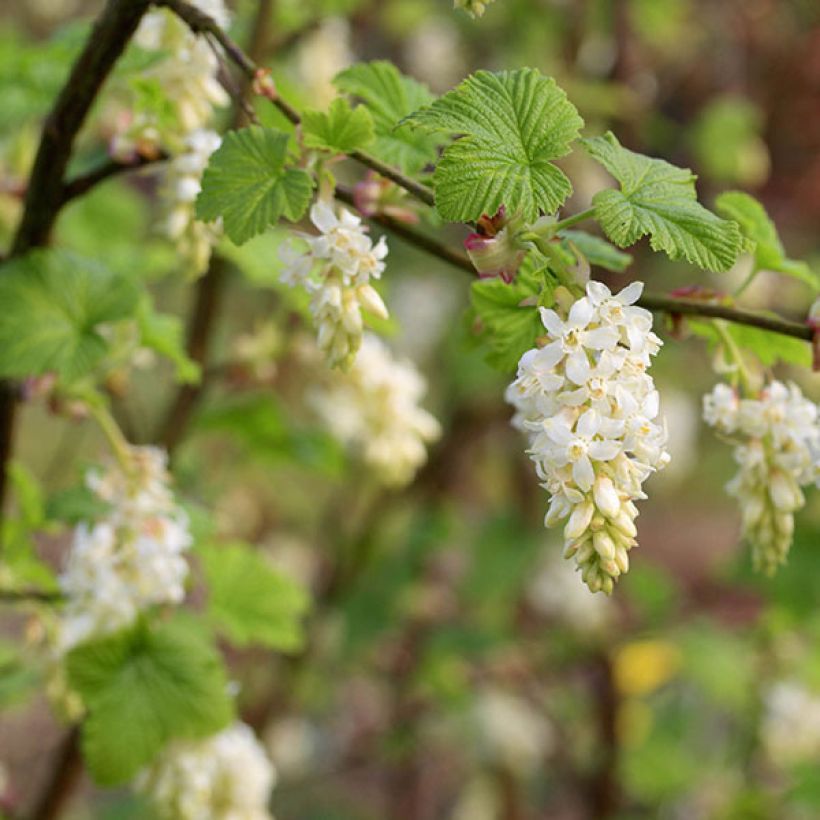

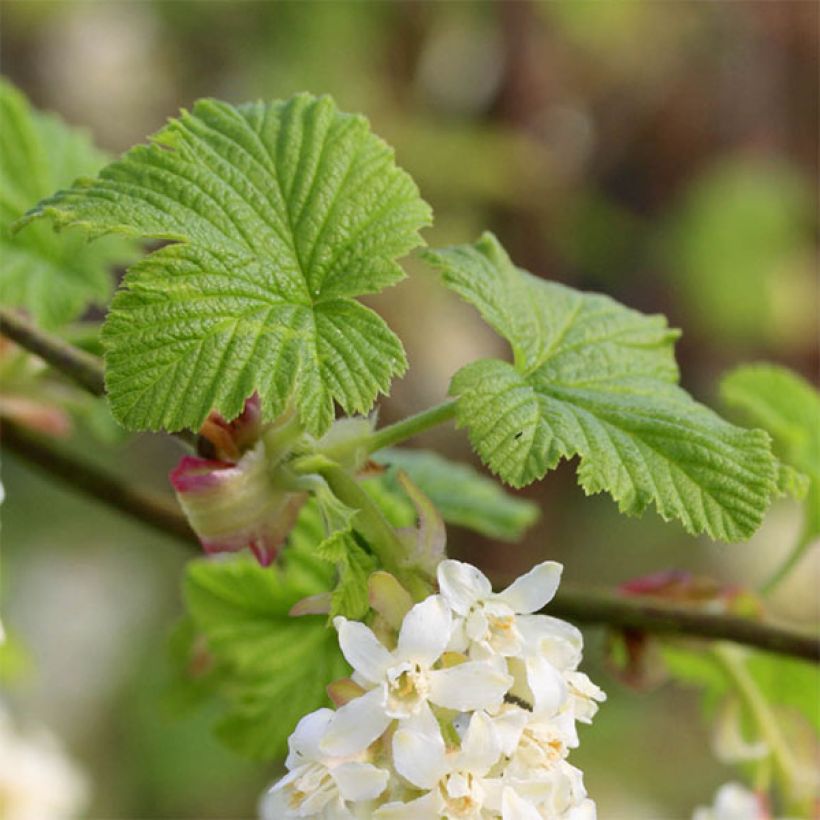

Plant habit
Flowering
Foliage
Botanical data
Ribes
sanguineum
White Icicle
Grossulariaceae
Flowering Currant, Red-flowered Currant, American Currant, Blood Currant
Cultivar or hybrid
Other Ribes - Flowering Currants
Planting and care
Ribes sanguineum White Icicle, very easy to grow, is perfectly suited for beginner gardeners. It is extremely hardy, tolerating temperatures as low as -20°C. It is therefore well adapted to harsh climates. It grows without problems in any good garden soil, moist and well-drained, but also appreciates fairly rich soil. However, it doesn't really tolerate soils that are too chalky or too dry. Very accommodating, it thrives in partially shaded, or even fully shaded, positions, but also enjoys a sunny exposure, as long as it's not too scorching. Planting can be done in spring or autumn, in open ground or in a pot, choosing a wide and deep container with potting soil or garden soil. It is advisable to bury part of the collar so that the new shoots can root quickly. In spring, a mulch in the form of compost or decomposed manure will be welcome. Propagation can be done by cuttings in August, by taking semi-woody stems, in other words, the tips of the shoots, 15 to 20cm (6 to 8in) long. Remove the leaves, keeping only the ones at the top, and plant in pots, in a mixture of potting soil and garden soil, well-drained, and ensure regular watering.
Planting period
Intended location
Care
-
, onOrder confirmed
Reply from on Promesse de fleurs
Hedge shrubs
Haven't found what you were looking for?
Hardiness is the lowest winter temperature a plant can endure without suffering serious damage or even dying. However, hardiness is affected by location (a sheltered area, such as a patio), protection (winter cover) and soil type (hardiness is improved by well-drained soil).

Photo Sharing Terms & Conditions
In order to encourage gardeners to interact and share their experiences, Promesse de fleurs offers various media enabling content to be uploaded onto its Site - in particular via the ‘Photo sharing’ module.
The User agrees to refrain from:
- Posting any content that is illegal, prejudicial, insulting, racist, inciteful to hatred, revisionist, contrary to public decency, that infringes on privacy or on the privacy rights of third parties, in particular the publicity rights of persons and goods, intellectual property rights, or the right to privacy.
- Submitting content on behalf of a third party;
- Impersonate the identity of a third party and/or publish any personal information about a third party;
In general, the User undertakes to refrain from any unethical behaviour.
All Content (in particular text, comments, files, images, photos, videos, creative works, etc.), which may be subject to property or intellectual property rights, image or other private rights, shall remain the property of the User, subject to the limited rights granted by the terms of the licence granted by Promesse de fleurs as stated below. Users are at liberty to publish or not to publish such Content on the Site, notably via the ‘Photo Sharing’ facility, and accept that this Content shall be made public and freely accessible, notably on the Internet.
Users further acknowledge, undertake to have ,and guarantee that they hold all necessary rights and permissions to publish such material on the Site, in particular with regard to the legislation in force pertaining to any privacy, property, intellectual property, image, or contractual rights, or rights of any other nature. By publishing such Content on the Site, Users acknowledge accepting full liability as publishers of the Content within the meaning of the law, and grant Promesse de fleurs, free of charge, an inclusive, worldwide licence for the said Content for the entire duration of its publication, including all reproduction, representation, up/downloading, displaying, performing, transmission, and storage rights.
Users also grant permission for their name to be linked to the Content and accept that this link may not always be made available.
By engaging in posting material, Users consent to their Content becoming automatically accessible on the Internet, in particular on other sites and/or blogs and/or web pages of the Promesse de fleurs site, including in particular social pages and the Promesse de fleurs catalogue.
Users may secure the removal of entrusted content free of charge by issuing a simple request via our contact form.
The flowering period indicated on our website applies to countries and regions located in USDA zone 8 (France, the United Kingdom, Ireland, the Netherlands, etc.)
It will vary according to where you live:
- In zones 9 to 10 (Italy, Spain, Greece, etc.), flowering will occur about 2 to 4 weeks earlier.
- In zones 6 to 7 (Germany, Poland, Slovenia, and lower mountainous regions), flowering will be delayed by 2 to 3 weeks.
- In zone 5 (Central Europe, Scandinavia), blooming will be delayed by 3 to 5 weeks.
In temperate climates, pruning of spring-flowering shrubs (forsythia, spireas, etc.) should be done just after flowering.
Pruning of summer-flowering shrubs (Indian Lilac, Perovskia, etc.) can be done in winter or spring.
In cold regions as well as with frost-sensitive plants, avoid pruning too early when severe frosts may still occur.
The planting period indicated on our website applies to countries and regions located in USDA zone 8 (France, United Kingdom, Ireland, Netherlands).
It will vary according to where you live:
- In Mediterranean zones (Marseille, Madrid, Milan, etc.), autumn and winter are the best planting periods.
- In continental zones (Strasbourg, Munich, Vienna, etc.), delay planting by 2 to 3 weeks in spring and bring it forward by 2 to 4 weeks in autumn.
- In mountainous regions (the Alps, Pyrenees, Carpathians, etc.), it is best to plant in late spring (May-June) or late summer (August-September).
The harvesting period indicated on our website applies to countries and regions in USDA zone 8 (France, England, Ireland, the Netherlands).
In colder areas (Scandinavia, Poland, Austria...) fruit and vegetable harvests are likely to be delayed by 3-4 weeks.
In warmer areas (Italy, Spain, Greece, etc.), harvesting will probably take place earlier, depending on weather conditions.
The sowing periods indicated on our website apply to countries and regions within USDA Zone 8 (France, UK, Ireland, Netherlands).
In colder areas (Scandinavia, Poland, Austria...), delay any outdoor sowing by 3-4 weeks, or sow under glass.
In warmer climes (Italy, Spain, Greece, etc.), bring outdoor sowing forward by a few weeks.

































